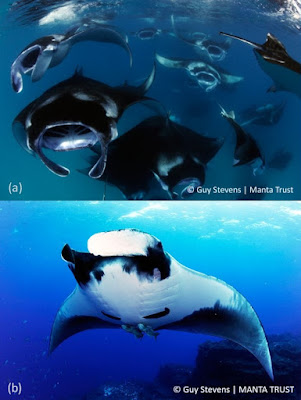 |
| Figure 1: Images of devil and manta rays. (A) Reef Manta Ray (Manta alfredi); (B) Oceanic Manta Ray (Manta birostris); (C) Shortfin Devil Ray (Mobula kuhlii); (D) Smoothtail Devil Ray (Mobula munkiana).
DOI: 10.7717/peerj.3027
|
Abstract
Background
International trade for luxury products, medicines, and tonics poses a threat to both terrestrial and marine wildlife. The demand for and consumption of gill plates (known as Peng Yu Sai, “Fish Gill of Mobulid Ray”) from devil and manta rays (subfamily Mobulinae, collectively referred to as mobulids) poses a significant threat to these marine fishes because of their extremely low productivity. The demand for these gill plates has driven an international trade supplied by largely unmonitored and unregulated catches from target and incidental fisheries around the world. Scientific research, conservation campaigns, and legal protections for devil rays have lagged behind those for manta rays despite similar threats across all mobulids.
To investigate the difference in attention given to devil rays and manta rays, we examined trends in the scientific literature and updated species distribution maps for all mobulids. Using available information on target and incidental fisheries, and gathering information on fishing and trade regulations (at international, national, and territorial levels), we examined how threats and protective measures overlap with species distribution. We then used a species conservation planning approach to develop the Global Devil and Manta Ray Conservation Strategy, specifying a vision, goals, objectives, and actions to advance the knowledge and protection of both devil and manta rays.
Our literature review revealed that there had been nearly 2.5-times more “manta”-titled publications, than “mobula” or “devil ray”-titled publications over the past 4.5 years (January 2012–June 2016). The majority of these recent publications were reports on occurrence of mobulid species. These publications contributed to updated Area of Occupancy and Extent of Occurrence maps which showed expanded distributions for most mobulid species and overlap between the two genera. While several international protections have recently expanded to include all mobulids, there remains a greater number of national, state, and territory-level protections for manta rays compared to devil rays. We hypothesize that there are fewer scientific publications and regulatory protections for devil rays due primarily to perceptions of charisma that favour manta rays. We suggest that the well-established species conservation framework used here offers an objective solution to close this gap. To advance the goals of the conservation strategy we highlight opportunities for parity in protection and suggest solutions to help reduce target and bycatch fisheries.
Julia M. Lawson, Sonja V. Fordham, Mary P. O’Malley, Lindsay N.K. Davidson, Rachel H.L. Walls, Michelle R. Heupel, Guy Stevens, Daniel Fernando, Ania Budziak, Colin A. Simpfendorfer, Isabel Ender, Malcolm P. Francis, Giuseppe Notarbartolo di Sciara and Nicholas K. Dulvy. 2017. Sympathy for the Devil: A Conservation Strategy for Devil and Manta Rays.
PeerJ. 5:e3027. DOI: 10.7717/peerj.3027
PeerJ. 5:e3027. DOI: 10.7717/peerj.3027
